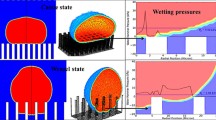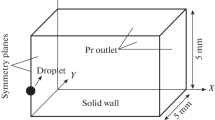Abstract
We numerically investigate bouncing and non-bouncing of droplets during isothermal impact on superhydrophobic surfaces. An in-house, experimentally validated, finite element method-based computational model is employed to simulate the droplet impact dynamics and transient fluid flow within the droplet. The liquid–gas interface is tracked accurately in Lagrangian framework with dynamic wetting boundary condition at three-phase contact line. The interplay of kinetic, surface and gravitational energies is investigated via systematic variation of impact velocity and equilibrium contact angle. The numerical simulations demonstrate that the droplet bounces off the surface if the total droplet energy at the instance of maximum recoiling exceeds the initial surface and gravitational energy, otherwise not. The non-bouncing droplet is characterized by the oscillations on the free surface due to competition between the kinetic and surface energy. The droplet dimensions and shapes obtained at different times by the simulations are compared with the respective measurements available in the literature. Comparisons show good agreement of numerical data with measurements, and the computational model is able to reconstruct the bouncing and non-bouncing of the droplet as seen in the measurements. The simulated internal flow helps to understand the impact dynamics as well as the interplay of the associated energies during the bouncing and non-bouncing. A regime map is proposed to predict the bouncing and non-bouncing on a superhydrophobic surface with an equilibrium contact angle of 155°, using data of 86 simulations and the measurements available in the literature. We discuss the validity of the computational model for the wetting transition from Cassie to Wenzel state on micro- and nanostructured superhydrophobic surfaces. We demonstrate that the numerical simulation can serve as an important tool to quantify the internal flow, if the simulated droplet shapes match the respective measurements utilizing high-speed photography.
Similar content being viewed by others
References
Bixlera G.D., Bhushan B.: Rice- and butterfly-wing effect inspired self-cleaning and low drag micro/nanopatterned surfaces in water, oil, and air flow. Nanoscale 6, 76–96 (2014)
Ou J., Perot B., Rothestein J.P.: Laminar drag reduction in microchannels using ultrahydrophobic surfaces. Phys. Fluids 16(12), 4635 (2004)
Bergeron V., Bonn B., Martin J.V., Vovelle L.: Controlling droplet deposition with polymer additives. Nature 405, 772–775 (2000)
Patil N.D., Bhardwaj R.: Evaporation of a sessile microdroplet on a heated hydrophobic substrate. Int. J. Micronano Scale Transp. 5(2), 51–58 (2014)
Betz A.R., Xu J., Qiu H., Attinger D.: Do surfaces with mixed hydrophilic and hydrophobic areas enhance pool boiling. Appl. Phys. Lett. 97, 141909 (2010)
Attinger D., Frankiewicz C., Betz A.R., Schutzius T.M., Ganguly R., Schutzius T.M., Das A., Kim C.J., Megaridis C.M.: Surface engineering for phase change heat transfer: a review. MRS Energy Sustain. 1, 1–40 (2014)
Bhardwaj R., Longtin J.P., Attinger D.: Interfacial temperature measurements, high-speed visualization and finite-element simulations of droplet impact and evaporation on a solid surface. Int. J. Heat Mass Transf. 53, 3733–3744 (2010)
Yarin A.L.: Drop impact dynamics: splashing, spreading, receding, bouncing. Ann. Rev. Fluid Mech. 38, 159 (2006)
Schiaffino S., Sonin A.A.: Molten droplet deposition and solidification at low Weber numbers. Phys. Fluids 9, 3172–3187 (1997)
Rider W.J., Kothe D.B.: Reconstructing volume tracking. J. Comput. Phys. 141, 112 (1998)
Osher S., Sethian J.A.: Fronts propagating with curvature-dependent speed: algorithms based on Hamilton–Jacobi formulations. J. Comput. Phys. 79, 12–49 (1988)
Pasandideh-Fard M., Qiao Y.M., Chandra S., Mostaghimi J.: A three-dimensional model of droplet impact and solidification. Int. J. Heat Mass Transf. 45, 2229–2242 (2002)
Liu H., Krishnan S., Marella S., Udaykumar H.S.: Sharp interface Cartesian grid method II: a technique for simulating droplet interactions with surfaces of arbitrary shape. J. Comput. Phys. 210, 32–54 (2005)
Caviezel D., Narayanan C., Lakehal D.: Adherence and bouncing of liquid droplets impacting on dry surfaces. Microfluid. Nanofluid. 5, 469–478 (2008)
Randive P., Dalal A., Mukherjee P.P.: Probing the influence of superhydrophobicity and mixed wettability on droplet displacement behavior. Microfluid. Nanofluid. 17, 657–674 (2014)
Fukai J., Zhao Z., Poulikakos D., Megaridis C.M., Miyatake O.: Modeling of the deformation of a liquid droplet impinging upon a flat surface. Phys. Fluids A 5, 2588–2599 (1993)
Zhao Z., Poulikakos D., Fukai J.: Heat transfer and fluid dynamics during the collision of a liquid droplet on a substrate—I. Modeling. Int. J. Heat Mass Transf. 39, 2771–2789 (1996)
Waldvogel J.M., Poulikakos D.: Solidification phenomena in picoliter size solder droplet deposition on a composite substrate. Int. J. Heat Mass Transf. 40, 295–309 (1997)
Attinger D., Poulikakos D.: Melting and resolidification of a substrate caused by molten microdroplet impact. J. Heat Transf. 123, 1110–1122 (2001)
Dietzel M., Poulikakos D.: Laser induced motion in nanoparticle suspension droplets on a surface. Phys. Fluids 17, 102–106 (2005)
Dietzel M., Bieri N.R., Poulikakos D.: Dropwise deposition and wetting of nanoparticle suspensions. Int. J. Heat Fluid Flow 29, 250–262 (2008)
Bhardwaj R., Longtin J.P., Attinger D.: A numerical investigation on the effect of liquid properties and interfacial heat transfer during microdroplet deposition onto a glass substrate. Int. J. Heat Mass Transf. 50, 2912–2923 (2007)
Bhardwaj R., Attinger D.: Non-isothermal wetting during impact of millimeter-size water drop on a flat substrate: Numerical investigation and comparison with high-speed visualization experiments. Int. J. Heat Fluid 29, 1422–1435 (2008)
Bhardwaj R., Fang X., Attinger D.: Pattern forming during the evaporation of a colloidal nanoliter drop: a numerical and experimental study. N. J. Phys. 11, 075020 (2009)
Bhardwaj R., Fang X., Somasundaran P., Attinger D.: Self-assembly of colloidal particles from evaporating droplets: role of the pH and proposition of a phase diagram. Langmuir 26(11), 7833–7842 (2010)
Sprittles J.E., Shikhmurzaev Y.D.: The dynamics of liquid drops and their interaction with solids of varying wettabilities. Phys. Fluids 24, 082001 (2012)
Blake T.D., De Coninck J.: The effect of solid–liquid interactions on dynamic wetting. Adv. Colloid Interface Sci. 66, 21 (2002)
Richard D., Quéré D.: Bouncing water drops. Europhys. Lett. 50(6), 769–775 (2000)
Clanet C., Béguin C., Richard D., Quéré D.: Maximal deformation of an impacting drop. J. Fluid Mech. 517, 199–208 (2004)
Bartolo D., Bouamrirene F., Verneuil É., Buguin A., Silberzan P., Moulinet S.: Bouncing or sticky droplets: impalement transitions on superhydrophobic micropatterned surfaces. Europhys. Lett. 74(2), 299–305 (2006)
Jung Y.C., Bhushan B.: Dynamic effects induced transition of droplets on biomimetic superhydrophobic surfaces. Langmuir 25(16), 9208–9218 (2009)
Tsai P., Pacheco S., Pirat C., Lefferts L., Lohse D.: Drop impact upon micro- and Nano-structured superhydrophobic surfaces. Langmuir 25(20), 12293–12298 (2009)
Chen L., Xiao Z., Chan P.C.H., Lee Y.K., Li Z.: A comparative study of droplet impact dynamics on a dual-scaled superhydrophobic surface and lotus leaf. Appl. Surf. Sci. 257, 8857–8863 (2011)
Wenzel T.N.: Surface roughness and contact angle. J. Phys. Colloid Chem. 53, 1466 (1949)
Cassie A.B.D.: Contact angles. Discuss. Faraday Soc. 3, 11 (1948)
Patankar N.A.: On the modeling of hydrophobic contact angles on rough surfaces. Langmuir 19, 1249–1253 (2003)
Wang Z., Lopez C., Hirsa A., Koratkar N.: Impact dynamics and rebound of water droplets on superhydrophobic carbon nanotube arrays. Appl. Phys. Lett. 91, 023105 (2007)
Jung Y.C., Bhushan B.: Wetting transition of water droplets on superhydrophobic patterned surfaces. Scr. Mater. 57, 1057–1060 (2007)
Lafuma A., Quéré D.: Superhydrophobic states. Nat. Mater. 2, 457–460 (2003)
Sikarwar B.S., Khandekar S., Muralidhar K.: Simulation of flow and heat transfer in a liquid drop sliding underneath a hydrophobic surface. Int. J. Heat Mass Transf. 57(2), 786–811 (2013)
Sakai M., Hashimoto A., Yoshida N., Suzuki S., Kameshima Y., Nakajima A.: Image analysis system for evaluating sliding behavior of a liquid droplet on a hydrophobic surface. Rev. Sci. Instrum. 78, 045103 (2007)
Hirt C.W., Nichols B.D.: Adding limited compressibility to incompressible hydrocodes. J. Comput. Phys. 34, 390–400 (1980)
Leal, L.G.: Advanced Transport Phenomena, p. 322. Cambridge University Press, Cambridge (2007)
Duchemin L., Josserand C.: Rarefied gas correction for the bubble entrapment singularity in drop impacts. C. R. Mec. 340, 792–803 (2012)
Josserand C., Zaleski S.: Droplet splashing on a thin liquid film. Phys. Fluids 15, 1650–1657 (2003)
Thoroddsen S.T., Etoh T.G., Takehara K., Ootsuka N., Hatsuki Y.: The air bubble entrapped under a drop impacting on a solid surface. J. Fluid Mech. 545, 203–212 (2005)
Kolinski J.M., Mahadevan L., Rubinstein S.M.: Drops can bounce from perfectly hydrophilic surfaces. Europhys. Lett. 108, 24001 (2014)
de Ruiter J., Lagraauw R., Van den Ende D., Mugele F.: Wettability-independent bouncing on flat surfaces mediated by thin air films. Nat. Phys. 11, 48–53 (2015)
Huh C., Scriven L.E.: Hydrodynamic model of steady movement of a solid/liquid/fluid contact line. J. Colloid Interface Sci. 35, 85 (1971)
Dussan V.E.B.: The moving contact line: the slip boundary condition. Ann. Rev. Fluid Mech. 77, 665–684 (1976)
Dussan V.E.B.: On the spreading of liquids on solid surfaces: static and dynamic contact lines. Ann. Rev. Fluid Mech. 11, 371–400 (1979)
Shikhmurzaev Y.D.: Moving contact lines in liquid/liquid/solid systems. J. Fluid Mech. 334, 211–249 (1997)
Haferl S., Zhao Z., Giannakouros J., Attinger D., Poulikakos D.: Transport phenomena in the impact of a molten droplet on a surface: macroscopic phenomenology and microscopic considerations. Part I: fluid dynamics. In: Tien, C.L. (eds) Annual Review of Heat Transfer XI, pp. 145–205. Begell House, New York (2000)
Ren W., W E.: Boundary conditions for the moving contact line problem. Phys. Fluids 19, 022101 (2007)
Sui Y., Hang D., Spelt P.D.M.: Numerical simulation of flows with moving contact lines. Ann. Rev. Fluid Mech. 46, 97–119 (2014)
Sprittles J.E., Shikhmurzaev Y.D.: Finite element framework for describing dynamic wetting phenomena. Int. J. Numer. Methods Fluids 68, 1257–1298 (2012)
Eggers J., Stone H.A.: Characteristic lengths at moving contact lines for a perfectly wetting fluid: the influence of speed on the dynamic contact angle. J. Fluid Mech. 505, 309–321 (2004)
Qian T., Wang X.P., Sheng P.: Molecular hydrodynamics of the moving contact line in two-phase immiscible flows. Commun. Comput. Phys. 1(1), 1–52 (2006)
Bach P., Hassager O.: An algorithm for the use of the Lagrangian specification in Newtonian fluid mechanics and applications to free-surface flow. J. Fluid Mech. 152, 173–190 (1985)
Bayer I.S., Megaridis C.M.: Contact line dynamics in droplets impacting on flat surfaces with different wetting characteristics. J. Fluid Mech. 558, 415–449 (2006)
Lide D.R.: CRC Handbook of Chemistry and Physics on CD-ROM, 81st edn. Chapman and Hall, London (2001)
Supplementary video data (Filename = Case1_Bouncing_We2pt34.avi)
Supplementary video data (Filename = Case2_NonBouncing_Wept45.avi).
Mao T., Kuhn D.C.S., Tran H.: Spread and rebound of liquid droplets upon impact on flat surfaces. Am. Inst. Chem. Eng. J. 43(9), 2169–2179 (1997)
Attane P., Girard F., Morin V.: An energy balance approach of the dynamics of drop impact on a solid surface. Phys. Fluids 19, 012101 (2007)
Richard D., Clanet C., Quéré D.: Contact time of a bouncing drop. Nature 417, 811 (2002)
Supplementary video data (Filename = Case4_Bouncing_theta158.avi)
Supplementary video data (Filename = Case5_NonBouncing_theta91.avi).
Reyssat M., Pépin A., Marty F., Chen Y., Quéré D.: Bouncing transitions on microtextured materials. Europhys. Lett. 74(2), 306–312 (2006)
Hyväluoma J., Timonen J.: Impact states and energy dissipation in bouncing and non-bouncing droplets. J. Stat. Mech. Theory Exp. 6, P06010 (2009)
Joshi A.S., Sun Y.: Numerical simulation of colloidal drop deposition dynamics on patterned substrates for printable electronics fabrication. J. Disp. Technol. 6(11), 579–585 (2010)
Vandre E., Carvalho M.S., Kumar S.: Delaying the onset of dynamic wetting failure through meniscus confinement. J. Fluid Mech. 707, 496–520 (2012)
de Gennes P.G., Brochard-Wyart F., Quéré D.: Capillarity and Wetting Phenomena: Drops, Bubbles, Pearls, Waves. Springer, New York (2003)
Author information
Authors and Affiliations
Corresponding author
Additional information
Communicated by S. Balachandar.
Electronic supplementary material
Below is the link to the electronic supplementary material.
Rights and permissions
About this article
Cite this article
Bange, P.G., Bhardwaj, R. Computational study of bouncing and non-bouncing droplets impacting on superhydrophobic surfaces. Theor. Comput. Fluid Dyn. 30, 211–235 (2016). https://doi.org/10.1007/s00162-015-0376-3
Received:
Accepted:
Published:
Issue Date:
DOI: https://doi.org/10.1007/s00162-015-0376-3




